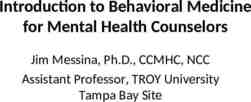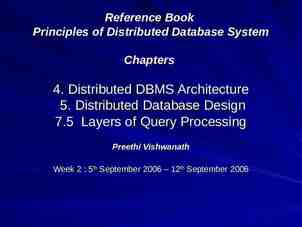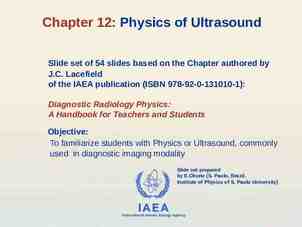Planting the seeds for educational success How KOHA helps to
26 Slides6.24 MB
Planting the seeds for educational success How KOHA helps to put California children on a path toward healthy and successful lives [Name of Presenter, Credentials Go Here] [Audience/Conference and Date Go Here]
What school readiness means Children’s educational future is shaped early in life: School readiness is much more than a child’s early learning and cognitive development. Head Start officials stress that physical health is a key part of school readiness. (Source: U.S. Department of Health and Human Services. “Making the Link between Health and School Readiness,” Office of Head Start, 2013)
Absenteeism’s impact Absenteeism lowers student achievement and drains funding from school districts. Dental-related absences cost our state’s public schools at least 29 million each year in average daily attendance funding. (Source: Torlakson T. “Kindergarten Oral Health Assessment Requirement,” letter from California Department of Education to county and district superintendents and charter school administrators, March 3, 2017)
Absenteeism is an equity issue School districts are required to report high absence rates to the U.S. Education Department’s office of Civil Rights Data Collection. (Source: The Education Trust. Chronic Absenteeism. Accessed April 8, 2019 at https://edtrust.org/students-cant-wait/chronic-absenteeism/)
Why is KOHA so important to school readiness and health? 1
Oral health & absenteeism Research shows children with poor dental health are nearly 3 times more likely to miss school than their healthier peers. In a single school year, roughly 504,000 California children missed at least one day of school due to a dental problem. (Sources: Jackson SL, Vann WF, Kotch JB, Pahel BT, Lee JY. Impact of Poor Oral Health on Children’s School Attendance and Performance. American Journal of Public Health 2011; 101(10), 1900-1906; Pourat N, Nicholson G. Unaffordable Dental Care Is Linked to Frequent School Absences. UCLA Center for Health Policy Research, November 2009)
Oral health & student performance A study of disadvantaged students from L.A. Unified found that students with recent dental pain were nearly 4 times more likely to have low grade-point averages. (Source: Seirawan H, Faust S, Mulligan R. “The Impact of Oral Health on the Academic Performance of Disadvantaged Children,” American Journal of Public Health. September 2012. Vol. 102, No. 9.)
The impact of poor oral health Untreated decay can cause pain, and it’s an infection that can spread to other parts of the body, where it has the potential to be fatal. Oral health problems can make it difficult for children to chew food, sleep at night, or socialize with other kids — and their selfesteem can suffer. (Source: Centers for Disease Control and Prevention, “Oral Health Conditions,” accessed on May 29, 2019 at https://www.cdc.gov/oralhealth/conditions/index.html)
Putting kids on a disturbing trajectory Early detection and regular prevention of dental disease is crucial to avoid severe disease that often requires invasive and costly treatment. Trips to a hospital ER (where children are often taken when tooth pain becomes severe) often lead to a prescription for opioids to control the pain, rather than treatment for the disease. DID YOU KNOW? Dental problems were the leading reason why teens and young adults were prescribed opioids after ER visits. (Source: Hudgins JD, Porter JJ, Monuteaux MC, Bourgeois, FT. Trends in Opioid Prescribing for Adolescents and Young Adults in Ambulatory Care Settings. Pediatrics 2019; 143:6)
Prevention can save families money Even families with private dental insurance for their children can pay hundreds or thousands of dollars out of pocket to treat tooth decay. Dental fillings don’t last forever. They eventually must be repaired or replaced. The lifetime costs of a single decayed tooth can reach up to 6,105. (Sources: Vujicic M, Yarbrough C. Estimating Premium and Out-of-Pocket Outlays Under All Child Dental Coverage Options in the Federally Facilitated Marketplace. The Journal of Pediatrics 2017; 182, 349-355; These data on the lifetime cost of decay were from Delta Dental of California, cited by the Children’s Dental Health Project, accessed at https://www.cdhp.org/state-of-dental-health/schoolandbeyond)
What does KOHA require parents to do? 2
The goal behind the KOHA Lowering student absenteeism was a major reason why California legislators voted in 2005 to create a Kindergarten Oral Health Assessment (KOHA).
What KOHA requires All children must have a dental checkup by May 31 of the year when they enter their first year in public school (kindergarten or 1st grade). Dental evaluations that have happened within the 12 months before a child enters school also meet this requirement. Each school gives parents the required form they need to take with them when the child has their checkup. (Source: Kindergarten Oral Health Requirement. California Dental Association. Accessed at https://www.cda.org/public-resources/kindergartenoral-health-requirement)
What KOHA requires If a parent/caregiver cannot get a dental checkup for their child, they can apply for the child to be excused from the requirement. This is done by filling out the waiver form (a separate sheet) and marking the reason why their child could not get the checkup. (Source: Kindergarten Oral Health Requirement. California Dental Association. Accessed at https://www.cda.org/public-resources/kindergartenoral-health-requirement)
For California’s children, prevention must start early. That’s what KOHA is all about. 3
Why prevention and care should start early In California, more than 50% of children in kindergarten already have experienced dental decay. Nearly 3 in 10 have untreated decay. By encouraging parents to have their kids screened, KOHA helps to identify decay before it progresses to an even more serious infection. (Source: These data are from the California Department of Public Health, Office of Oral Health. Visit https://www.cdph.ca.gov/Programs/CCDPHP/DCDIC/CDCB/Pages/OralHealthProgram/OralHealthProgram.aspx.)
Other reasons why KOHA matters Participating in KOHA will enable local school boards to learn more about the factors that affect absenteeism. The National Association of State Boards of Education says it’s crucial to examine student health data so school officials “understand the drivers of chronic absence.” (Source: National Association of State Boards of Education. State Boards Should Explore Health-Related Causes of Chronic Absence. News release issued February 21, 2019.)
Other reasons why KOHA matters KOHA raises parents’ and caregivers’ awareness that oral health is important. KOHA can help us connect children with a dental home — a dental clinic or other location where they can get ongoing care.
Other reasons why KOHA matters Local health departments and dental providers can use KOHA data to target areas of need within a school district. Tooth decay is a preventable disease. Schools and local health officials can work together, putting children on a path toward better health and academic success. DID YOU KNOW? In San Francisco, KOHA data spurred new strategies that helped significantly reduce tooth decay among kindergarten students.
Other reasons why KOHA matters KOHA advances California’s commitment to Health in All Policies. This kind of inter-sector approach is needed because education and health impact each other in both directions. State officials created a task force to coordinate this work. (Source: Rudolph L, Caplan J, Ben-Moshe K, Dillon L. Health in All Policies: A Guide for State and Local Governments, 2013. Washington, DC and Oakland, CA: American Public Health Association and Public Health Institute.)
KOHA has diverse supporters Here are some of the many California stakeholders that actively support our KOHA law:
California must (and can) do a better job of promoting KOHA participation to families. 4
Helping you make KOHA work Efforts are being made to make it easier for schools and school districts to participate in KOHA. An online database called SCOHR (System for California Oral Health Reporting) makes it much easier for schools to upload and review their KOHA data at no cost. This fall, free training will be offered for school staff across the state on how to use SCOHR
KOHA is not a “one size fits all” program Some counties are partnering with nonprofit organizations to make it easier for parents to get dental screenings for their children and fill out their form right then. Another option can be for a school district to partner with the local dental society. We can share a few ideas for facilitating dental assessments for children in your school or district.
What you can do Adopt a resolution putting your organization on record in support of KOHA Agree to distribute or display handouts about KOHA to parents who attend your events or seek your services [Insert another appropriate “ask”] [Insert another appropriate “ask”]
Thank you! [Your name goes here] P: [Phone number goes here] E: [[email protected]]







